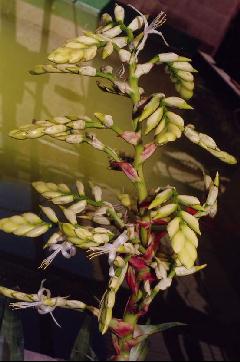
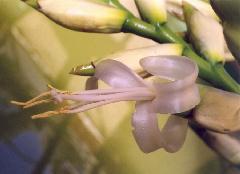
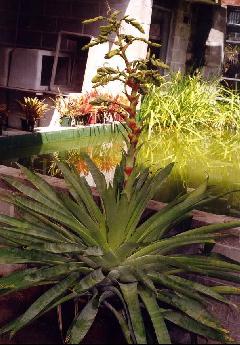
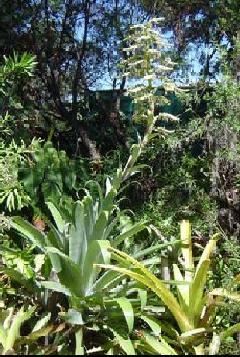
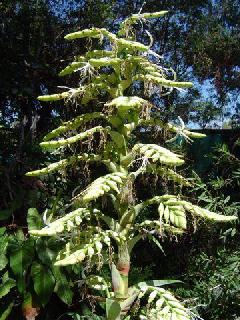
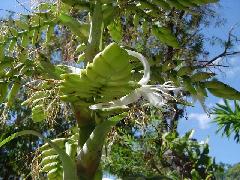
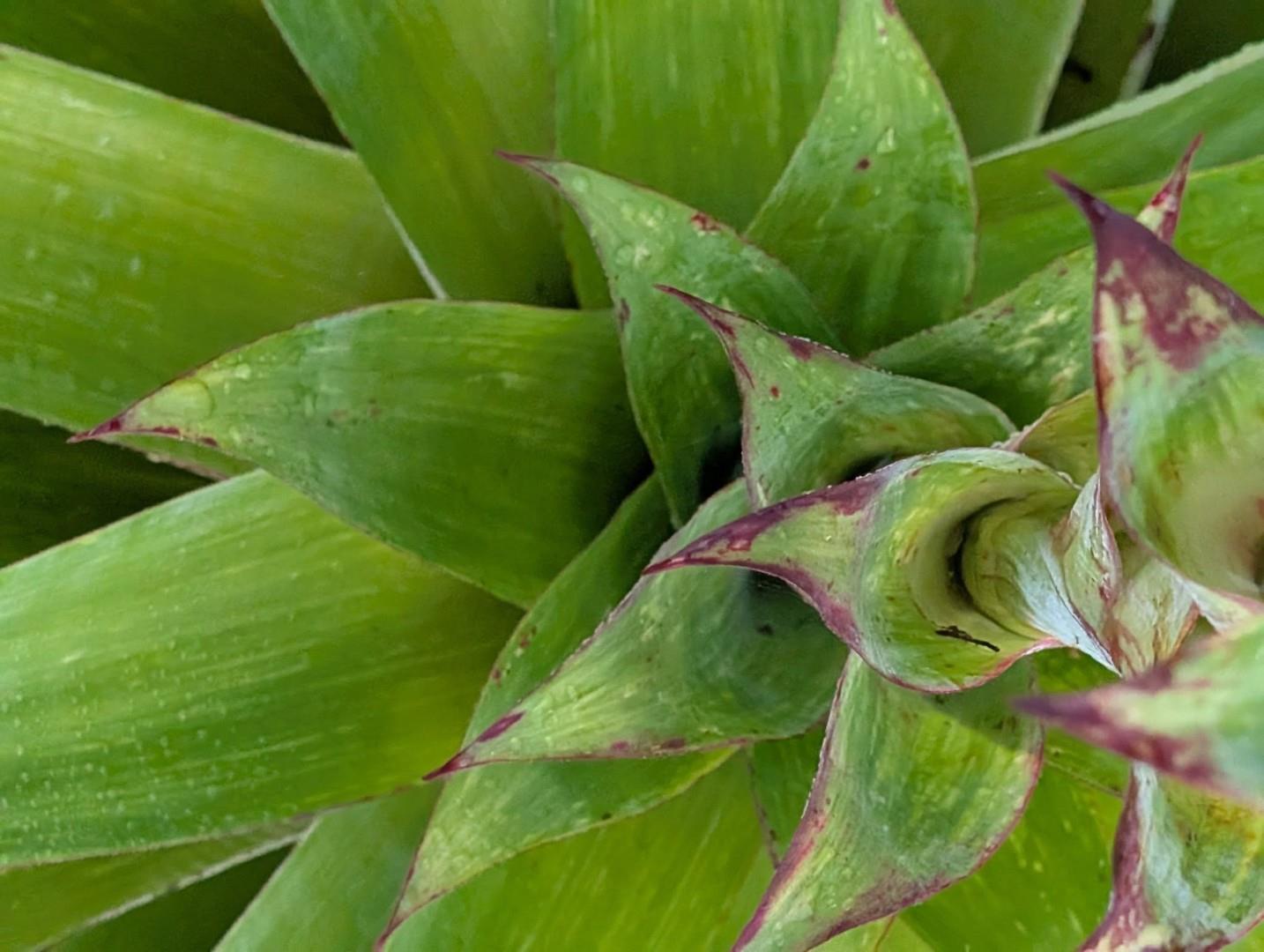
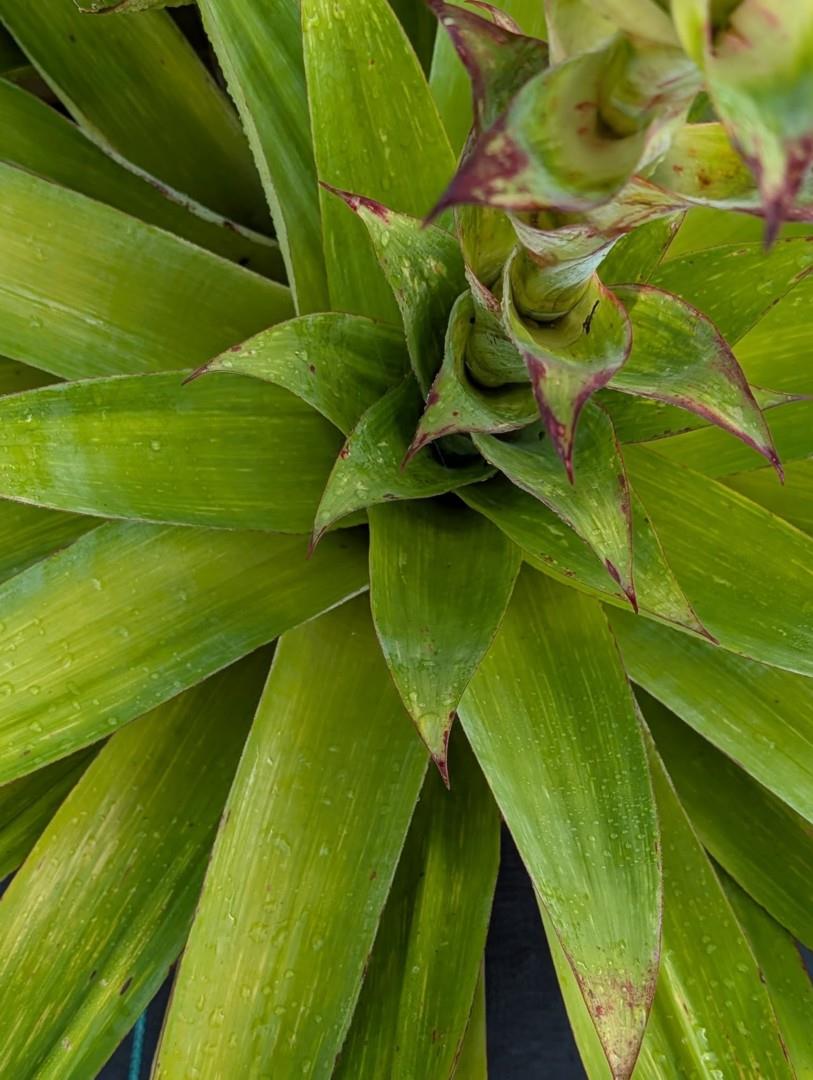
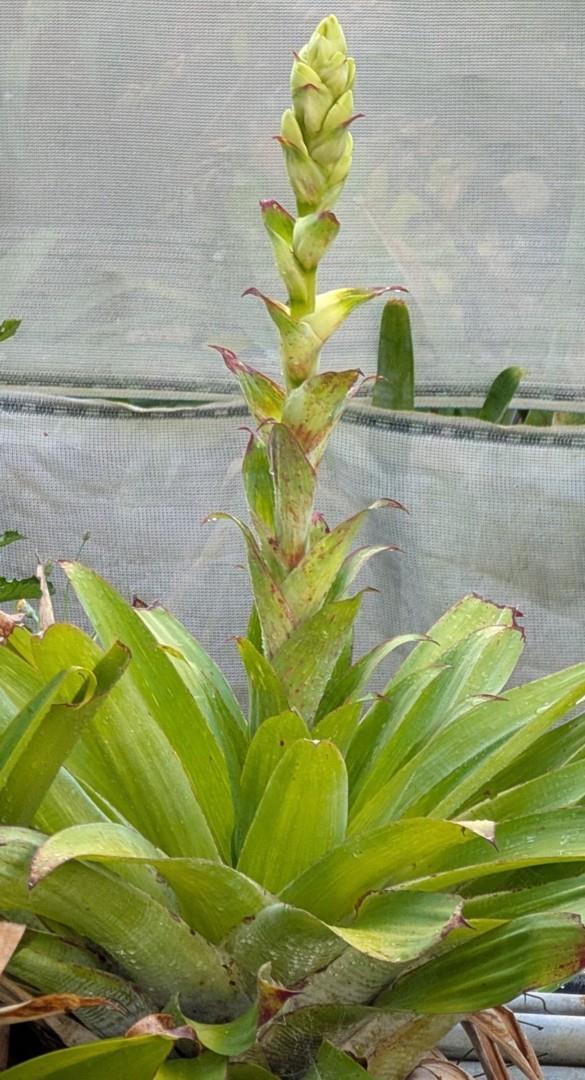
Alcantarea glaziouana (Lemaire) Leme , comb. nov Bromelia #2 June 1997.
Basionym: Vriesea glaziouana Lemaire, Ill. Hort, 14 (Misc.): 43, fig. 2, Jun. 1867.
Synonym: Vriesea regina sensu auct. anon. Gard, Chron. n. ser: 3: 234, fig. 41. 1875; non Beer, 1857.
Vriesea vasta Mez in Martius Fl. bras, 3 (3): 572, 1894. Type: Rio de Janeiro, Copacabana, Glaziou 15468, Lectotype: B. Isolectotypes: C, P, n. v.; K. Clonotypes: B (exsicata/sheet II), K.
Desc from Bromelia #2 June 1997 by E Leme
PLANT lithophytic, flowering 150-170 cm high;
LEAVES ca. 50, densely rosulate, suberect-arcuate, forming a broad funnel form rosette at base;
SHEATHS broadly elliptic, 25 x 17 -19 cm, densely and minutely brown-lepidote on both sides, pale colored;
BLADES narrowly triangulate-attenuate, 65-100 cm long, 9-14 cm wide near the base, not narrowed at base, apex acuminate and recurved, glabrous and green on both sides but the inner ones with narrow, white-cretaceous crossbands.
SCAPE ca. 100 cm long, 2-3 cm in diameter, rigid, erect, longer than the leaves, reddish to red, glabrous;
SCAPE BRACTS suberect, concealing the scape, distinctly longer than the internodes, reddish and white-cretaceous toward base, green toward apex, the basal ones foliaceous, the upper ones resembling the basal primary bracts.
INFLORESCENCE paniculate, sub-densely bipinnate, 70-90 cm long, 50-60 cm in diameter, erect;
PRIMARY BRACTS the basal ones with a broadly elliptic to suborbiculate base, 5-6 x 7-8 cm, and a narrowly triangulate-attenuate, suberect blade, 10-18 cm long, ca. 4 cm wide at base, glabrous but densely white-cretaceous, reddish toward base, green toward apex, distinctly exceeding the sterile base of the branches, the upper ones broadly ovate to suborbiculate, acute to acuminate, 5-9 x 4-6 cm, equal to or slightly shorter than the sterile bases of the branches, red;
BRANCHES 25-30, subspreading, triangulate before to sublinear after anthesis, 8-10 cm wide ( excluding petals ), subdensely flowered, the basal ones ca. 30 cm long, with 12-20 flowers,
PEDUNCLE 10-13 cm long, ca. 0.8 cm in diameter, rigid, reddish, glabrous, bearing 2 to 3, light yellow to greenish-yellow, carinate to obtusely carinate at apex, sterile bracts, the upper ones 20-25 cm long, peduncle 5-6 cm long, bearing a single sterile bract at apex;
RHACHIS slightly flexuous before to geniculate after anthesis, glabrous, greenish, 5- 7 mm in diameter, internodes 10-20 mm long;
FLORAL BRACTS suborbiculate, (25- ) 30-40 x (25- ) 3037 rnro, apex obtuse to emarginate, distinctly sulcate, subrigid in texture but not coriaceous, ecarinate, light greenish-yellow to whitish, minutely lepidote inside, enfolding the flowers at anthesis, about equaling the midpoint of the sepals, not inflated nor incurved, the basal ones slightly gibbous at base, the upper ones slightly imbricate before anthesis only.
FLOWERS distichous, not secund, suberect, 4.5-5.5 cm long ( excluding petals ), strongly fragrant, pedicels stout, 12-13 mm long, 10-12 mm in diameter;
SEPALS symmetric, broadly elliptic to obovate, obtuse to subacute, 30-35 x 18-22 mm, glabrous outside, inconspicuously brown-lepidote inside, free, ecarinate, green toward base and thick near the base, light yellowish-green to whitish toward apex;
PETALS sublinear, apex obtuse, (70- ) 90-95 x (9- ) 13 mm, pale cream before anthesis and white at anthesis, strongly recurved at anthesis, then flaccidescent, bearing 2 sublinear, subacute to obtuse or irregularly dentate, ( 15- ) 25 x 4-5 mm appendages at base with free lobes 5 x 5 mm;
STAMENS equalling the petals but exposed at anthesis;
ANTHERS linear, 15- 18 mm long, base and apex obtuse, fixed near the base;
STYLE surpassing the anthers, ca. 10 cm long;
STIGMA simple-erect, white, blades spreading, ca. 3 mm long.
TYPE: Rio de Janeiro, Glaziou s. n. Holotype: lost, if in fact a specimen was ever made. Lectotype: Ill. Hort. 14 (Misc.): plate 516. May, 1867.
In June 1867, Lemaire described V. glaziouana and referred to plate 516, published earlier. He also presented a drawing of a dry branch (figure 2 of the original work). The description was based on a specimen from the rocky cliffs near Rio de Janeiro, sent by A. Glaziou.
Vriesea glaziouana should be regarded as distinct from A. geniculata, although it is closely related to this species morphologically. Important traits that justify this decision include a larger, denser leaf rosette with more leaves; wider inflorescence (50-60 cm vs. 30-40), branches ( from base to apex of inflorescence ) longer (20-30 cm vs. 12-25 cm), with larger basal peduncles (basal 10- 13 cm vs. 5-8 cm); rhachis slightly flexuous at anthesis; floral bracts ecarinate, larger [(25- ) 30-40 x (25- ) 30-37 mm vs. 27 x 23-25 mm ], suborbicular and more widely enfolding the calyx; sepals wider ( 18-22 mm vs. 13-16 mm); petals entirely white at anthesis, while those of A. geniculata are golden yellow. Furthermore, V glaziouana has a more restricted geographic range; it is endemic to the rocky cliffs in the vicinity of Rio de Janeiro, near sea level. It is more common in this area than A. geniculata which does not grow at the same sites, according to the data available today. Vriesea glaziouana (placed below in the genus Alcantarea) is abundant in Copacabana, Urca, Grajau, Jacarepaguci, Barra da Tijuca, Recreio dos Bandeirantes and Grumari. This species is also common round the town of Niteroi, on the other side of the Guanabara Bay.
One of the synonyms of A. glaziouana listed here is Vriesea regina as depicted in the periodical "The Gardeners' Chronicle", published in February 1875 - not as conceived by Beer, 1857, based on Vellozo, 1831. According to this publication, which cites Edouard Morren, V. regina is identical to Lemaire's V glaziouana. The short description and drawing of the full plant leave no doubt that the specimen shown is A. glaziouana.
The other synonym is Vriesea vasta, whose type specimens (Glaziou 15468), according to the protologue, are from Copacabana, a district of Rio de Janeiro, where it still grows today on the Pedra do Leme. The lectotype (selected here) is deposited in the Botanical Museum of Berlin (B); it is composed of exsiccata numbered from I to V, consisting of the following: I )A leaf, an upper branch of the inflorescence and a primary bract, origin: "Rio de Janeiro, Copacabana"; II ) The upper half of an inflorescence with three branches, the label (handwritten) states: "Vriesea glazioviana, Sao Cristovao, 17 novembro 1883"; this may be a clonotype that flowered in cultivation, in Sao Cristovao; III ) The apex of an inflorescence with five branches; IV and V) each with a single leaf. One of the V. vasta isolectotypes examined (Glaziou 15468), deposited in the herbarium of the Royal Botanic Gardens, Kew, England (K), is composed of three exsiccata, consisting of the following: I ) A single leaf (possibly a clonotype) labeled "Vriesea vasta Mez n. sp, Sao Cristovao, RJ, 17 nov, 1883"; II ) Two leaves, with a label above stating "V. vasta Mez", a note handwritten on the herbarium sheet, at lower left, stating "Vriesea glazioviana Lem.", and a label at lower right with the inscription "Environs de Rio Janeiro et D'Ouro Preto, 15468, 1883-84, Coll. Mons. A. Glaziou. Comm May 1885." It is important to note that these data do not exclude the locality cited in the protologue; III ) Two upper sections of the inflorescence, each with two branches, and with the same inscriptions found on the preceding exsiccata, grouped in the lower left corner.
From Mez in Das Pflanzenreich 1935
111. V. vasta Mez in Mart. Fl. Brasil. III. 3. (1894) 572. –
Plurimetralis. Folia perlonge acuta, haud picta, metralia, ad 0,14 m lata. Scapus percrassus, vaginis foliaceis, internodia longe superantibus indutus. Inflorescentia plurimetralis, ramulis flores 12-15 nullo modo secundos gerentibus, haud geniculatis; bracteis florigeris suborbicularibus, late rotundatis, haud incurvis nec inflatis, obtuse carinatis, ad 28 mm longis et 35 mm latis, quam sepala brevioribus. Flores suberecto-patentes, ad 95 mm longi, fragrantissimi; sepalis acutiusculis, ad 35 mm longis, haud carinatis. Petala e lacteo lutescentia, fasciata, sepalis ad 33 mm longiora, ligula unica 2-partita praedita.
Brasilien : Staat Rio de Janeiro, bei Capocabana ( Glaziou n. 15468).
Plant flowering several metres high.
Leaves very long acute, not at all coloured, 1 m long, to 0,14 m lata.
Scape very thick, sheaths leaflike, internodes long exceeding.
Inflorescence several metres long, floral branches 12-15 not at all secund, not geniculate;
Floral bracts suborbicular, broad rounded, not at all incurved nor inflated, obtuse carinate, to 28 mm long et 35 mm wide, shorter than the sepals.
Flowers suberect to spreading, to 95 mm long, very fragrant;
Sepals slightly acute, to 35 mm long, not at all carinate.
Petals from milky to yellowish, barred, to 33 mm longer than the sepals, with one ligule in 2 parts.
Brazil: State of Rio de Janeiro, near Copacobana ( Glaziou n. 15468).